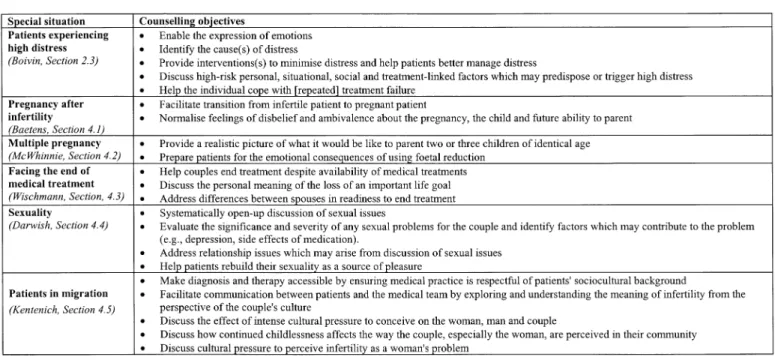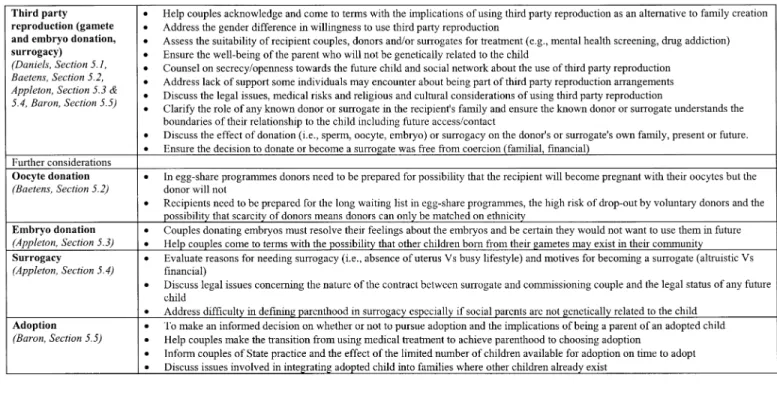Guidelines for counselling in infertility: outline version
Texte intégral
(2) J.Boivin et al.. Table I. Objectives when using adjunct (additional) psychosocial services. Table II. Counselling objectives in special situations. psychosocial care is provided throughout the treatment experience. To help fertility clinics meet these objectives, we have developed the Guidelines for Counselling in Infertility. These Guidelines show how patient-centred care can be integrated into the day-to-day activities of the medical team and how professional counselling can be used to meet any extraordinary patient need. The Guidelines for Counselling in Infertility have been discussed and written collaboratively with individuals from many countries. It is hoped this team effort has generated a set of Guidelines that encompass the psychosocial issues faced by infertile couples and the way in which counsellors from different countries can address them. The Guidelines are intended for both medical staff and mental health professionals and it is hoped that information contained therein will help both groups to maintain good practice with regard to psychosocial care for infertile couples. Naturally, the Guidelines will require revision as new issues emerge and/or some issues become more or less important. Already some topics, for 1302. example preimplantation genetic diagnosis, which were excluded from this version are planned for the revision of the Guidelines. It is also hoped that the Guidelines can be revised in light of feedback from the community of professionals working with infertile individuals. The complete Guidelines for Counselling in Infertility could not be included in the journal, and what follows is therefore a summary. However, the full text can be accessed through the ESHRE website (http://www.eshre.com). In the following summary, citations in parentheses refer to specific authors and sections of the complete Guidelines. Outline The infertility medical experience can be thought of as a 10step recurrent cycle that the patient can enter, exit and re-enter at any point (see Section 3, J.Bitzer). The process begins with the initiation of the therapeutic relationship and ends with the outcome and evaluation of a given treatment. Each step in the.
(3) Guidelines for counselling in infertility. Table III. Counselling objectives in third party reproduction. Table IV. Additional objectives for counselling in social infertility. cycle will have a purpose and a set of objectives and each step will present typical issues and will require specific communication skills. These aspects of the consultation are usually addressed from a medical perspective. However, they can also be addressed from a psychosocial perspective. For example, the purpose of the first meeting with patients is to provide a helpful and competent environment, with the objectives being to ensure that patients feel understood, respected and reassured. The communication skills involved at this stage might be as basic as remembering who the patient is (e.g. their names, professions) or as complex as detecting the negative feelings that patients are unable to express. Some of the typical issues encountered in a first meeting are that the team environment does not allow patients to overcome feelings of embarrassment and shame, or that it treats the patient anonymously. This example illustrates how psychosocial care can be integrated in the first step of the medical cycle, that is, the initial meeting. The Guidelines describe how such patientcentred care can be integrated into other steps of the medical. process (e.g. considering treatment options, evaluating treatment outcome). The physician plays an important part in ensuring that psychosocial care is integrated into patient care through his/ her relationship to the patient as well as the entire team (see Section 2.4, H.Kentenich). Depending on past training, physicians can also be involved in the counselling of infertility patients, though for the most part physicians will refer patients to trained counsellors for this aspect of their treatment experience. In any case, physicians should have good communication skills and a basic knowledge of counselling. The nature of psychosocial care will vary from clinic to clinic, depending on the country’s legal and social framework. Despite these potential sources of differences, it is possible to identify two broad types of psychosocial care that have been the subject of discussion (see Section 2.1, B.Strauss and J.Boivin). ‘Patient-centred care’ is the psychosocial care provided as part of routine services at the clinic. ‘Counselling’, on the other hand, involves the use of psychological interventions 1303.
(4) J.Boivin et al.. based on specific theoretical frameworks. Whereas patientcentred care is expected from all members of the medical team at all times, counselling is typically delivered by someone having received training in the mental health professions (e.g. psychology, social work, counselling). It is important to have both types of care available. Patient-centred care will vary from answering questions to providing support after distressing events such as a negative pregnancy test. Clinics can increase their overall level of patient-centred care by providing other non-professional services that may be useful to patients. Table I presents some of the objectives and typical issues that might arise from using these additional psychosocial services (see Section 6.1, J.Boivin, Section, 6.2, 6.3, P.Thorn). Counselling, on the other hand, aims to address the extraordinary needs of some patients (see Section 2.1, B.Strauss and J.Boivin). Counselling might include individual and couple therapy and/or professionally facilitated support groups. The content of counselling may differ depending on the patient and the treatment choice but will usually involve at least some form of information and implication counselling, support or therapeutic counselling. Information and implication counselling might focus on ensuring that individuals understand the different psychosocial issues involved in their treatment choice whereas therapeutic counselling might involve an understanding of the emotional consequences of childlessness. A key difference between patient-centred care and counselling is the counsellor’s level of training (see Section 2.2, E.Corrigan, K.Daniels and P.Thorn). Guidance concerning qualifications for counsellors working with infertile patients has been provided by different organizations and/or governmental bodies. While an agreed set of criteria for ‘who should counsel’ has yet to emerge, at the minimum counsellors should have received training in one of the mental health professions (e.g. psychology, social work, counselling) as well as training in the medical aspects of reproduction. As noted previously, all staff can and should provide patient-centred care but only professionally trained individuals can provide counselling. The Guidelines describe some of the practical issues that need to be addressed between counsellors and the team with whom they work. These issues might include whether the counsellor will be involved in the assessment and/or screening of patients for treatment and whether counsellors will work independently or within the clinic environment. Other issues may arise when, for example, the treating physician is also providing the counselling. A review of the literature identifies three populations who might benefit from and/or require counselling. The first group represents the majority of patients seen by the counsellor –. 1304. patients who experience very high levels of distress (see Section 2.3, J.Boivin). The distress may be manifested in different ways (e.g. depression, anxiety), but is generally perceived by the patient as being overwhelming and difficult to manage. While highly distressed patients form a significant proportion of those using professional counselling, they make up only ~20% of all infertility patients. The purpose and objective of counselling in such cases will vary depending on the source of distress. The Guidelines describe some of the personal characteristics that may place someone at risk for high distress (e.g. preexisting depression) and some of the situations that may trigger high distress (e.g. failed treatment, fetal reduction). Table II describes some of the special situations which may lead to high distress and some of the objectives and typical issues which arise from counselling in these situations. The second group of patients who use counselling are those couples requiring donated gametes, surrogacy and/or adoption to achieve parenthood. So-called third-party reproduction is thought to provoke psychological and emotional issues that go beyond the counselling issues involved in treatments not requiring a ‘third party’. Table III summarizes some of the objectives and typical issues that arise from counselling with individuals requiring a ‘third party’ for family building. The final group of patients who benefit from counselling are those who seek fertility services because of their social circumstances rather than their medical status. Single and lesbian women who use donated spermatozoa or gay men who use surrogacy fall in this category. While these individuals will also face the general issues described in Table III for third party reproduction, they also face issues that are specific to ‘social’ infertility. Table IV describes some of the objectives and typical issues that arise in counselling with this group of patients. Conclusions Good practice in infertility clinics encompasses more than medical care. Clinics need to be prepared to take into account and deal with the psychosocial issues that confront couples who use their services. The basic aim of any counselling (whether patient-centred or professional) is to ensure that patients understand the implications of their treatment choice, receive sufficient emotional support and can cope in a healthy way with the consequences of the infertility experience. A more holistic approach to patient care is believed to improve health outcomes, increase patient and team satisfaction, reduce negative psychosocial reactions and help patients better come to terms with their experiences..
(5)
Figure


Documents relatifs
[r]
Through analyzing the dialectic contradiction between form and content in roll film snapshots and digital photos, we have reached the conclusion that photos could be
Humanitarian Aid: Switzerland’s humanitarian engagement is fully embedded in the Swiss Foreign Policy Strategy 2016-19 and the new Dispatch on Switzerland’s International
to study the risk factors associated with calving dif- ficulty, placental retention and
Comparison of in vitro follicle-stimulating hormone (FSH) activity of equine gonadotropins (luteinizing hormone, FSH, and chorionic gonadotropin) in male and female rats.
Is not able t o c omf or t child, and child does not look to car egiv er for comfort: Help caregiver look into child’s eyes, gently talk to child and hold child. Ho w does car
Both could be the only management needed for controlling blood glucose in gestational diabetes and IGT and in type 2 diabetes in its early phase. • Patients with type 2 diabetes